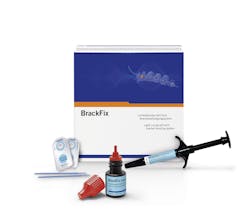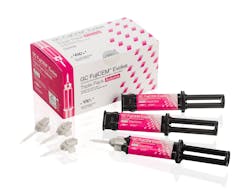BrackFix fluorescent bracket bonding system from Voco
Having spoken with many of my general dentist colleagues, I think it is fair to say that we often see young patients after two or more years of orthodontic treatment, only to discover large quantities of cement coating the facial surfaces of their teeth. I asked a respected orthodontist colleague, Cassandra Gandia, DDS, how cement can be missed at the debond visit. Her response was that orthodontists judge orthodontic cements (often referred to as adhesives) based on a variety of characteristics, including bond strength, ease of flash elimination, and ease of removing the brackets and cement upon completion of treatment.
With those criteria in mind, and since I do not place orthodontic brackets, I invited Dr. Gandia to try BrackFix and offer her evaluation. Here’s what she had to say: “BrackFix is a novel orthodontic cement with very unique characteristics that set it apart from other orthodontic cements, such as the ease of removing flash before photocuring a bracket and that BrackFix holds the bracket in position without slippage.”
She continued: “The showstopping quality of BrackFix is its ability to reveal all of the remaining cement upon debond. The amazing attribute of this adhesive is that it can be seen only under a 365 nm black light (it fluoresces blue). If there is any flash on the tooth around the bracket it will not be visible to the patient. However, upon debond, it becomes extremely easy for the orthodontist to visualize the flash for elimination simply by shining a UV light on the teeth.”
This unique feature will undoubtedly minimize tooth discoloration and the formation of future decay. The kit is available with either BrackFix Primer (in a bottle) for those who prefer an etch-and-rinse technique, or BrackFix Primer SE (in unit doses) for those who prefer not to etch separately prior to placing the bracket. The adhesive itself is delivered via syringe with no “oozing” and allows for direct placement of all brackets, ceramic or metal, without slipping prior to photocuring.
SurgiTel Wireless LED loupe light
I am a big fan of wireless devices and a big fan of SurgiTel loupes. Consequently, I was anxious to try the new SurgiTel Wireless LED for my loupes. I am quite impressed with this new wireless loupe light, which can be mounted to SurgiTel flip-up or through-the-lens (TTL) loupes, or to other loupes.
This new light is the brightest in the market, according to the manufacturer, and with high-quality optics, it features a neutral-colored beam that is ideal when doing cosmetic procedures for which you want no color distortion. This is a very lightweight (less than two ounces) LED, with two available models: Micro Optics and Mini Optics. Both models provide a crisp, clean, clear, wide beam of light that is adjustable in intensity. The Mini has a low intensity of 2,500 foot-candles, a medium intensity of 4,000, and a high intensity of 5,500. The Micro has a low intensity of 1,500 foot-candles, a medium intensity of 2,400, and a high intensity of 3,000.
A simple tap turns the light on or off. The light can be locked in a set brightness position. The unit comes with three lithium batteries and a charging unit. The batteries charge in about two hours, and they last from one hour and 45 minutes to three and a half hours, from maximum to low intensity, respectively. An amber flip-up filter is available, which I strongly recommend to avoid shortening the working time of your composite resin. This is an invaluable light for clear, bright visualization of the operating field.
GC FujiCem Evolve glass ionomer cement
Evolution—the earth evolved, humans evolved, and now an already great cement has evolved. Eighteen years ago, GC America introduced GC FujiCem. Seven years ago, GC FujiCem 2 was introduced. Today, we have GC FujiCem Evolve, a better product that features strontium glass, fluoride release, a three-second tack cure (due to a new photo initiator), and a new syringe that allows for either hand mixing or automixing.
This product was developed in direct response to the market’s demand for easier delivery systems and the increasing use of zirconia for crowns and bridges. This is a cement that can be used with a variety of substrates used for inlays, onlays, crowns, bridges, and metal, ceramic, or fiber posts. GC FujiCem Evolve’s demonstrated bond strength and durability are quite high. When bonding zirconia, it is particularly strong and stable. This is due to its excellent wettability because of its hydrophilic monomer chain and the interaction between polyacrylic acid and zirconia with low expansion to ensure a long-lasting bond.
While I am not a fan of hand mixing, I applaud GC America for the ingenious two-barrel syringe, which allows for hand mixing without the potential risk of paste-paste contamination, and the “push and click” tip that affixes to the syringe for automixing, which is easier and eliminates any chance of bubbles. Also, GC FujiCem Evolve is available in a new brighter and less chromatic universal shade. But perhaps the best reason to try GC FujiCem Evolve is because it is being offered at the same price as GC FujiCem 2.
About the Author

Howard S. Glazer, DDS, FAGD
Howard S. Glazer, DDS, FAGD, is a fellow of the Academy of General Dentistry, American College of Dentists, International College of Dentists, American Society for Dental Aesthetics, American Academy of Forensic Sciences, and a diplomate of the American Board of Aesthetic Dentistry. He is an attending dentist at the Englewood Hospital in Englewood, New Jersey, and the deputy chief forensic dental consultant to the Office of Chief Medical Examiner, City of New York.


